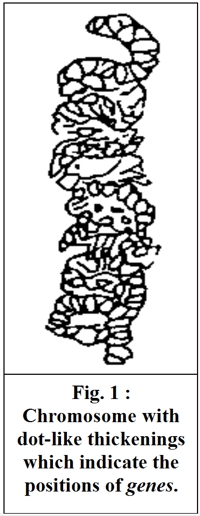 As a result of decades of observations and breeding experiments. We now know that the nuclear material of the cell is organized in the form of minute rod-like structures (see fig. 1). These minute structures in thin tissue slices can be seen by staining them with certain dyes which they take up more readily than the rest of the cell. It is this property of becoming visible by means of dyes which gave them the name "chromosome" (chroma = colour, soma = body).
As a result of decades of observations and breeding experiments. We now know that the nuclear material of the cell is organized in the form of minute rod-like structures (see fig. 1). These minute structures in thin tissue slices can be seen by staining them with certain dyes which they take up more readily than the rest of the cell. It is this property of becoming visible by means of dyes which gave them the name "chromosome" (chroma = colour, soma = body).
Chromosomes in turn are not homogeneous compositions nor single constituents. They are strings of those particles of heredity we earlier called genes, whose existence had been inferred from numerous breeding experiments, like those of Mandela. Such experiments had clearly shown that all the heritable characteristics of organisms are transmitted unchanged without "dilution or blending" because they are carried by distinct indivisible particles of heredity Mendel called factors and which we know call genes. Although genes have since been found to be actually very complex structures, being ultra-microscopic speeks of nucleic acid which can reproduce themselves by copying, they are transmitted from parent to progeny as indivisible units of heredity so that they behave very much like atoms in chemistry. These 'atoms' of heredity, the genes are arranged in a very precise way in the nucleus of the cells of the organism. Literally hundreds or thousands of them are wrapped together linearly in microscopic packets we have called chromosomes. Thus if genes are atoms of heredity, chromosomes are its macro molecules. The study of heredity is, therefore, the study of genes and chromosomes.
As already mentioned, each chromosome carries hundreds or thousands of genes. The human cell, for example, has been estimated to carry at least 40,000 genes, possible twice as many. This number may seen large. But it is not so large when we consider the complexity of development activities that the genes have to monitor. For it is the genes that are responsible for all that is inborn and inherited in us. Thus, it is the type of genes we inherit that determines our sex, blood group, vision (whether normal or colour blind) eye and skin colours, metabolic propensities, mental powers and thousand other traits that make up our physical and mental personalities.
Such similarities between parents and progeny as that of eye and skin colour of type of blood group are not the kind of stuff that can be packed in genes for onward 'transmission'. What is transmitted is a set of blue print "instructions" that determine broadly the course of development, and growth from conception to birth, then to adulthood senility and death. These instructions are embodied in the genes and chromosomes, in a code we have yet to decipher fully, but in principle it is analogous to a program tape of a computer which carries the 'instructions' for making it work in the desired way. Chromosomes and genes are thus in a manner of speaking micro miniaturized 'tapes' of heredity, the software of heredity that activates the computer hardware of environment.[105]
 Prof. Dr. Sohan Raj Tater
Prof. Dr. Sohan Raj Tater
 Doctoral Thesis, JVBU
Doctoral Thesis, JVBU